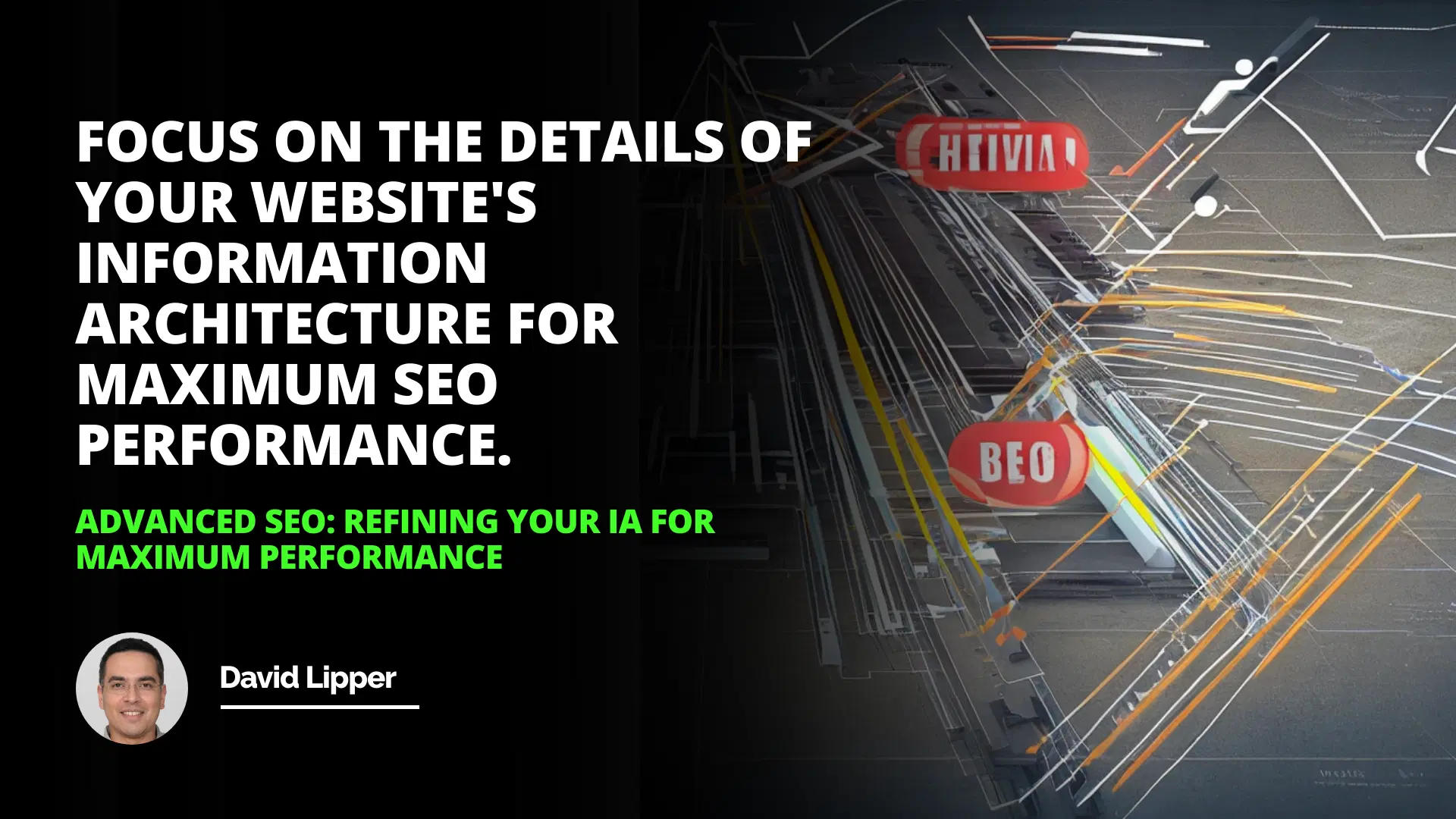
This article discussed advanced techniques for developing a practical Information Architecture (IA), which is essential for successful websites and applications. Techniques discussed include cross-referencing, descriptive anchor text, breadcrumb navigation, and minimizing link depth. These techniques help to provide users with a clear and intuitive structure for the organization of content and a logical navigation path.
Introduction
Advanced IA Development
Cross-references Should Be Cross-Linked
Descriptive Anchor Text
Implement Breadcrumb Navigation
Introduction
Developing an effective Information Architecture (IA) is a crucial step in planning and implementing a successful website or application. A practical IA should provide a clear and intuitive structure for the organization of content and a logical navigation path for users to follow. This article will discuss advanced IA development techniques, including cross-referencing, descriptive anchor text, breadcrumb navigation, and minimizing link depth.
Advanced IA Development
The first step in developing a practical IA is to conduct keyword research and then map out the site architecture. When mapping out the site architecture, it is essential to keep the number of categories as low as possible without making them so broad that the classification is no longer helpful. Once the site architecture is mapped out, several additional techniques can be used to refine further and enhance the IA.
Cross-references Should Be Cross-Linked
It is essential to consider how to cross-reference content that could reasonably fall into more than one category. For example, on Amazon.com, many products are cross-referenced using the “frequently bought together” and “customers who bought this item also bought” sections. Additionally, hashtags can be used to cross-reference content.
Descriptive Anchor Text
When linking to internal content, descriptive anchor text must accurately reflect the page or asset being linked to. This will help users understand the link's context and make it easier for search engines to understand the page's content.
Implement Breadcrumb Navigation
Breadcrumb navigation is a helpful navigational element that allows users to keep track of their location within the site easily. It is typically displayed as a series of links at the top of the page, allowing users to jump back to previous pages quickly.
Refactor Your Architecture to Minimize Link Depth
Link depth is the number of clicks required to reach a page from the homepage. It is essential to minimize link depth as much as possible, as users may be discouraged from visiting pages requiring too many clicks. To minimize link depth, it is essential to refactor the site architecture to ensure that pages are as close to the homepage as possible.
Conclusion
Developing an effective IA is a crucial step in planning and implementing a successful website or application. Advanced IA development techniques, such as cross-referencing, descriptive anchor text, breadcrumb navigation, and minimizing link depth, can help refine and enhance the IA. By implementing these techniques, websites, and applications can provide users with a clear and intuitive structure for the organization of content and a logical navigation path.
Focus on the details of your website's information architecture for maximum SEO performance.

Frequently Asked Questions
What are the key elements of advanced SEO for refining my IA for maximum performance?
Search engine optimization, commonly referred to as SEO, is an integral part of optimizing a website for maximum performance. SEO is a set of strategies and tactics designed to increase the visibility of a website in search engine results pages (SERPs). To maximize performance, website owners must refine their information architecture (IA) to ensure search engines correctly index the site. This article will discuss the key elements of advanced SEO for refining IA for maximum performance.
First and foremost, website owners should ensure that their IA is appropriately structured to maximize the effectiveness of their SEO efforts. This includes creating a logical site architecture with siloed categories, a logical URL structure, and a sitemap. Additionally, website owners should use internal linking to organize content and ensure that search engines index all pages.
Another critical element of advanced SEO is keyword research and optimization. Website owners should identify relevant keywords, monitor keyword performance, and optimize content for those keywords. Keyword optimization includes keywords in the title tag, meta description, headings, and body copy. Additionally, website owners should use alt tags on images to further optimize for keywords.
Finally, website owners should use content marketing and link building to optimize their SEO efforts further. Content marketing involves creating valuable and relevant content for users and then promoting it through various channels, such as social media and email. Link building involves creating backlinks from other websites to your own. This helps search engines identify your website as a quality source of information, which can increase rankings in SERPs.
In conclusion, advanced SEO for refining IA for maximum performance involves a combination of strategies and tactics, including restructuring the IA, keyword research and optimization, and content marketing and link building. By optimizing their IA, website owners can ensure that their website is correctly indexed by search engines and visible to potential customers.
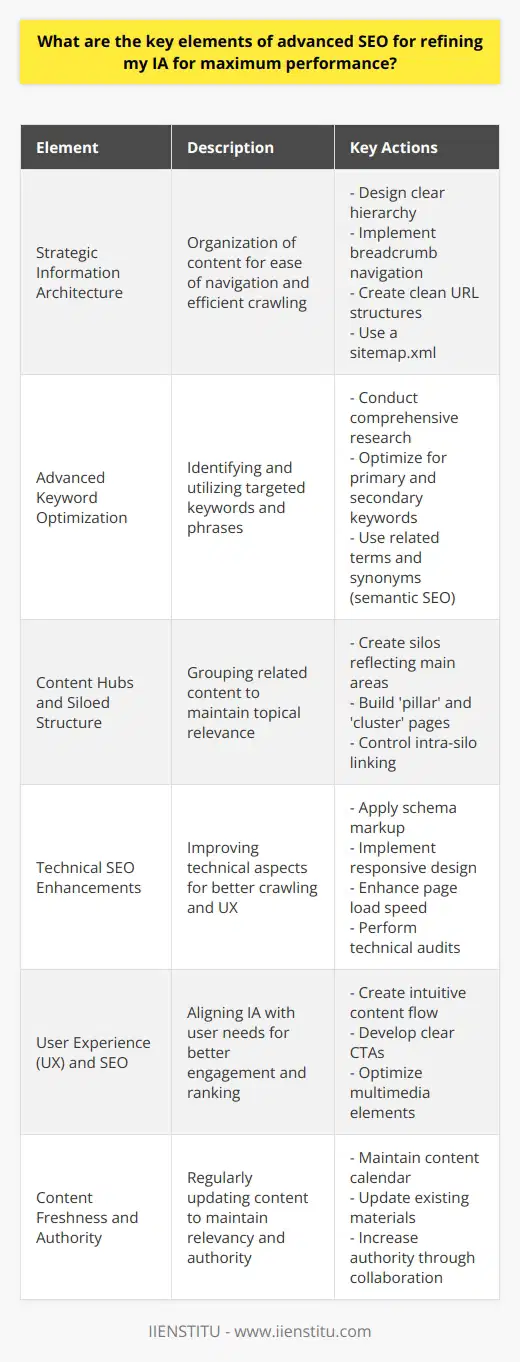
How can I use cross-references to improve my IA?
Cross-referencing is a valuable tool for anyone looking to improve the readability and navigability of their informational architecture (IA). Cross-references create links between different parts of the IA, allowing users to quickly and easily navigate from one page to another. This article will discuss how cross-references can enhance IA usability and user experience.
The first step in using cross-references to improve IA is to ensure that the IA is appropriately organized. The IA should be structured so that related content is grouped logically and each page is easily identifiable by its title or description. This will make it easier for users to locate the content they are looking for, as well as help to reduce the time they spend navigating the IA.
Once the IA is appropriately organized, cross-references can create links between different parts of the IA. Links should be placed between related pages, such as pages discussing similar topics or pages that contain supplementary information. These links will allow users to quickly and easily access the content they want, improving the overall user experience.
When creating cross-references, it is essential to consider the context in which they will be used. Links should be placed clearly and logically and should only be used to link related pages. Additionally, links should be placed in the text in a way that flows naturally rather than being placed awkwardly or unnaturally.
Cross-references can also be used to improve the readability of IA. Users can easily access supplementary information by creating links between related pages without reading through the entire page. This can help reduce the user’s cognitive load and make the IA more enjoyable to read.
Finally, cross-references can also be used to improve the navigability of the IA. Users can quickly and easily jump between different parts of the IA by creating links between related pages. This can help reduce the time users spend navigating the IA, as well as increase the overall user experience.
In conclusion, cross-references can be an effective tool for improving IA usability and user experience. By creating links between related pages, users can quickly and easily access the content they are looking for, reducing the time they spend navigating the IA. Additionally, cross-references can improve the readability and navigability of the IA, making it easier and more enjoyable for users to read.
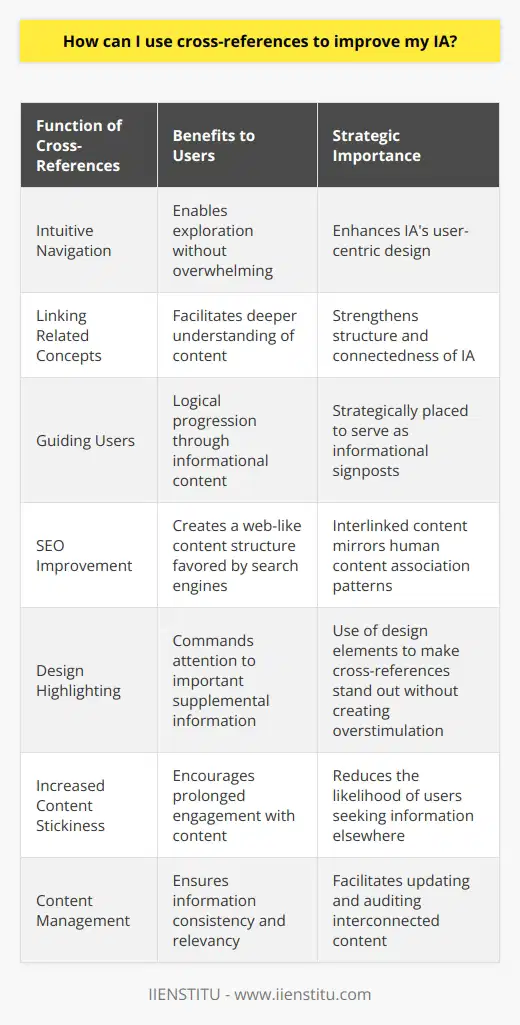
What is the best way to use descriptive anchor text to optimize my IA?
As a website owner, it is essential to establish a well-structured information architecture (IA) for website navigation. The IA is the foundation of a website, as it determines how content is organized and how users access information. One of the critical components of IA optimization is the use of descriptive anchor text, the clickable text used to link to other pages. Descriptive anchor text allows users to understand the link's context, which increases usability and improves the user experience.
To optimize a website's IA, it is essential to use descriptive anchor text that accurately describes the content of the linked page. This ensures that users clearly understand where the link will take them, which increases the chances of them clicking on the link. Additionally, this type of anchor text can help search engines better understand the link's context, leading to improved rankings.
When creating descriptive anchor text, it is essential to focus on creating short, concise phrases that accurately describe the content of the linked page. Long, complex expressions can be complicated for users to understand and may not accurately reflect the content of the linked page. Additionally, using keywords in the anchor text can help reinforce relevant search engine terms, further improving the website's rankings.
Finally, it is important to include descriptive anchor text in the body of a website page, as this can help to provide more context for a link. For example, instead of using a generic phrase such as “click here”, a more descriptive phrase such as “learn more about our services” can be used. This not only helps users to understand the purpose of the link but also provides search engines with more information about the linked content.
By utilizing descriptive anchor text, website owners can improve their IA and ensure that users have an easy and intuitive experience when navigating their website. Additionally, this type of anchor text can help improve search engine rankings, providing search engines with more information about the linked content. As such, website owners must focus on creating descriptive anchor text to optimize their IA.
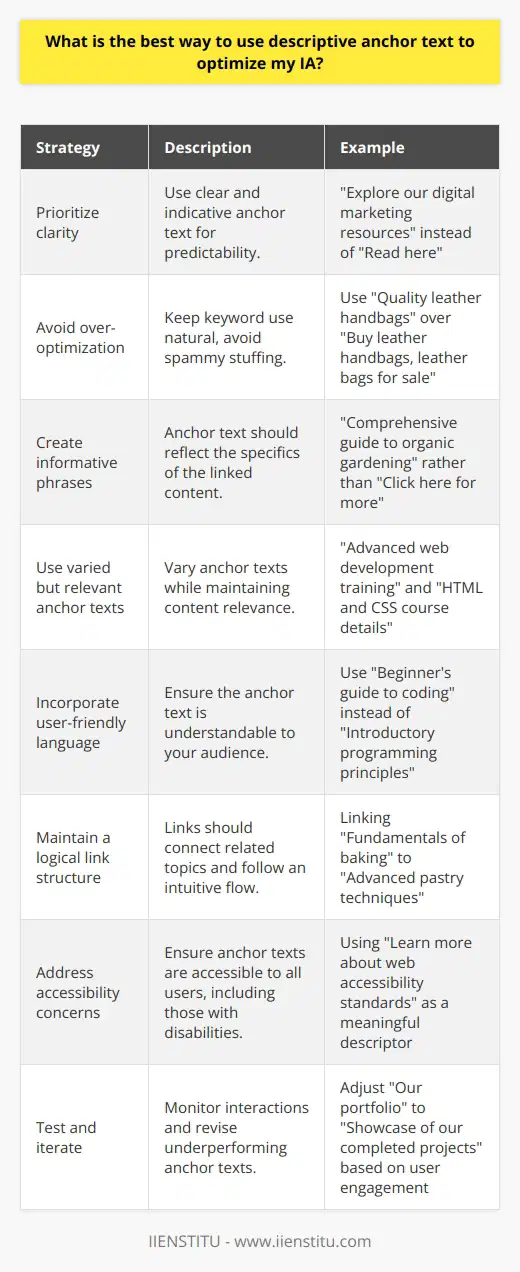
What are the most effective methods for optimizing my website's information architecture using advanced SEO strategies?
Understanding the Factors Behind Optimization
The most effective methods for optimizing a website's information architecture with advanced SEO strategies include identifying the key factors that contribute to better search engine rankings. First and foremost is keyword research, which involves discovering and using relevant, high-quality keywords within the content, meta-tags, headings, and URLs.
Prioritizing Hierarchical Structure
An efficient hierarchical structure is another aspect that benefits SEO optimization. The use of a logical, organized, and accessible menu system ensures that search engines can easily crawl the site, while users navigate seamlessly. This organization minimizes the reliance on deep-linking, which often leads to a negative impact on overall SEO performance.
Utilizing Topical Clustering
Topical clustering is another technique that effectively improves SEO strategy. This method involves creating topic-specific pages that cover a range of related subjects in depth. Grouping content into clusters enhances the website's subject matter expertise, making it more visible and relevant to search engines.
Embracing Mobile Responsiveness
Mobile responsiveness is an essential aspect of advanced SEO strategies. A website that functions smoothly across multiple devices and screen sizes is more likely to experience a boost in search engine rankings. Additionally, mobile-ready sites drive better user engagement, which positively affects SEO performance.
Implementing Proper Schema Markup
Using schema markup or structured data enhances search engine understanding of a website's content. Integrating this markup further optimizes a site's information architecture by providing clearer guidelines for search engines to consume and process information. In turn, this enhances the website's chances of being found and ranked higher in searches.
Encouraging Quality Backlinks
Lastly, fostering quality backlinks to a website is a highly effective method in optimizing information architecture. Gaining backlinks from authoritative sources provides solid proof of a website's content credibility, thereby increasing online visibility and search engine rankings.
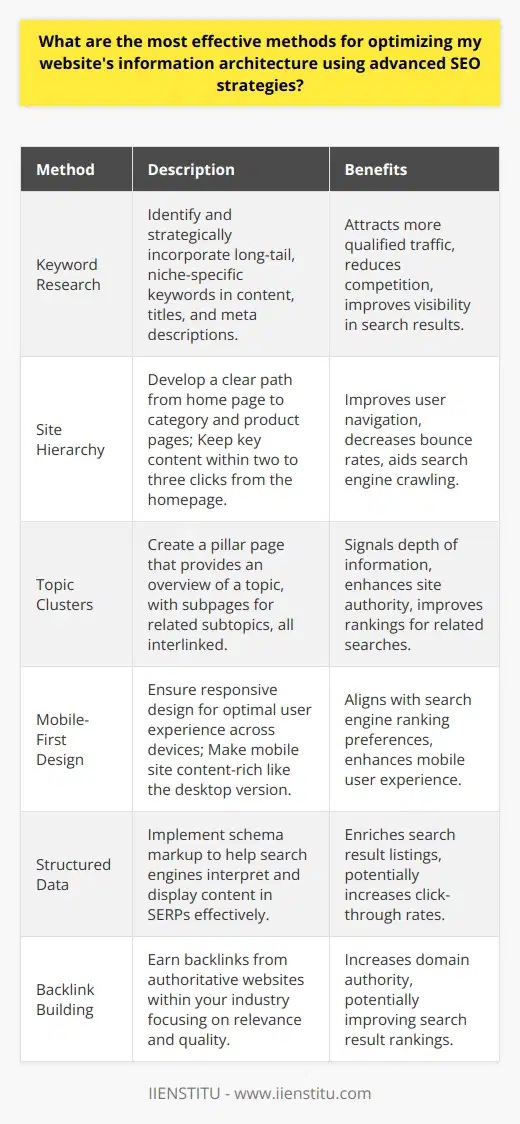
How can I effectively evaluate the success and impact of an SEO agency's work on my online presence?
Establishing Evaluation Criteria
To effectively evaluate the success and impact of an SEO agency's work on one's online presence, it is crucial to establish clear evaluation criteria beforehand. These criteria should include specific and measurable indicators that reflect the expected outcomes and benefits from the SEO work. The key performance indicators (KPIs), such as organic traffic, keyword rankings, and conversion rates, must align with the overall goals and objectives of the website.
Monitoring Progress and Analytics
Continuous monitoring of analytics data is essential to assess the effectiveness of the SEO agency's work. Utilizing different analytics tools, such as Google Analytics, enables identification of trends and patterns in website traffic performance and user behavior. Monitoring the performance metrics that are relevant to the defined KPIs helps in understanding the impact of the SEO work and identifying areas for improvement. Tracking the progress over an extended period of time ensures that the evaluation is comprehensive, reliable, and comparable.
Analyzing Keyword Performance
A pivotal element of SEO effectiveness is the keyword performance, which indicates the website's visibility in search engine results. Keyword rankings for targeted search terms are critical in assessing the success of the SEO agency's efforts. Moreover, the keyword performance should be evaluated not only in terms of rankings but also in relation to the quality of traffic they attract. For instance, improvements in target keywords should ideally result in increased organic traffic and user engagement.
Measuring Conversion Rates and Return on Investment
The ultimate purpose of any SEO work is to contribute positively to the business goals by generating leads, sales, or revenue. Therefore, measuring conversion rates and return on investment (ROI) is critical for evaluating the success of an SEO agency's work. Examining the correlation between improved SEO performance and an increase in conversions gives a clear indication of the effectiveness of the agency's efforts. Furthermore, comparing the cost of the SEO services to the revenue generated by the website offers a direct assessment of the ROI.
Seeking User Feedback and Improved User Experience
Lastly, considering the user perspective ensures that the SEO work aligns with the needs and preferences of the target audience. Seeking user feedback via online surveys, polls, or interviews helps to understand their experience while navigating the website. The feedback should reveal if there were any improvements in the user experience due to the SEO work. Improvements in site structure, content quality, and loading times contribute to both user satisfaction and search engine ranking.
In conclusion, evaluating the success and impact of an SEO agency's work on one's online presence requires a multi-dimensional approach. Establishing evaluation criteria, monitoring progress and analytics, analyzing keyword performance, measuring conversion rates and ROI, and considering user experience improvements are all crucial aspects that must be considered for a comprehensive evaluation.
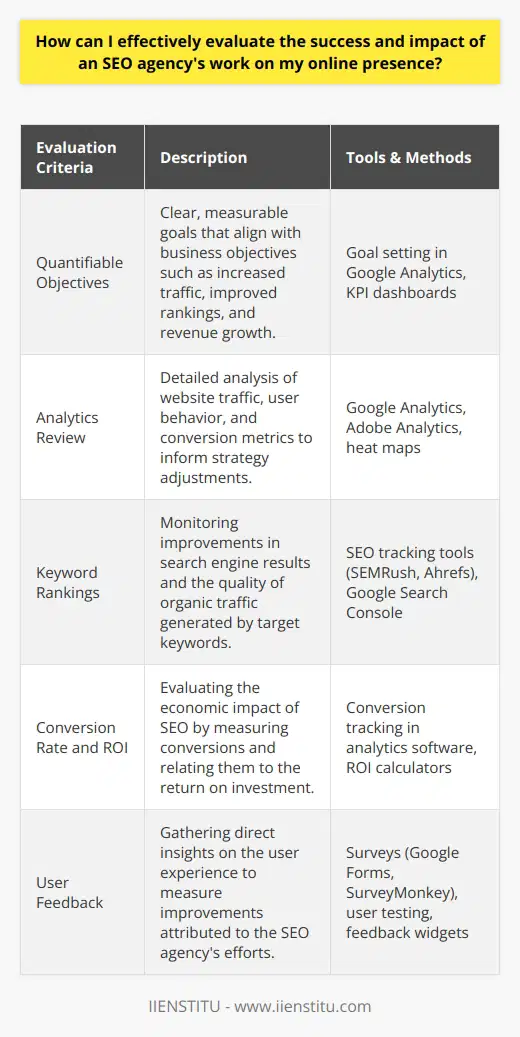
What specific actions can I take to enhance my website's SEO performance using innovative techniques and best practices?
Keyword Research and Integration
To enhance a website's SEO performance, one must first conduct thorough keyword research, which involves identifying relevant and high-ranking keywords to target in the blog post. Utilizing tools such as Google Keyword Planner, SEMrush, or Ahrefs can provide essential data for making informed decisions about which keywords to focus on.
Content Optimization
In addition to targeting specific keywords, it is crucial to create high-quality, engaging, and informative content that provides value to the readers. Moreover, it is essential to optimize the content by incorporating SEO best practices, such as using succinct and descriptive headings, incorporating internal and external links, and employing semantic markup to provide context to search engines. Including visual elements like images and videos with proper alt text and captions can also boost SEO performance by increasing user engagement and making the content more accessible.
Meta Tags and Descriptions
To further improve the website's SEO performance, it is necessary to optimize meta tags and descriptions. Writing concise and informative meta titles and descriptions, including targeted keywords, can significantly impact the click-through rate and search engines' understanding of the page content. Additionally, customizing the URL structure by incorporating keywords and avoiding complex characters can improve search engine visibility.
Mobile-Friendliness and Site Speed
In the age of smartphones, it is crucial to ensure that the website is mobile-friendly and responsive across devices to provide the best user experience. Furthermore, improving the website's loading speed is essential as it directly affects both the user experience and SEO rankings. Employing techniques such as enabling browser caching, compressing images, and minimizing JavaScript and CSS files can significantly enhance site loading speed, contributing to better overall SEO performance.
Regular Monitoring and Analysis
Lastly, it is vital to regularly monitor and analyze the website's SEO performance using tools like Google Analytics, Search Console, and Ahrefs. By keeping track of the website's performance, the webmaster can identify any critical issues, downtrends, or opportunities for growth and adjust the strategy accordingly. Continuous optimization of the website through regular monitoring and analysis can lead to sustainable success and long-term improvements in SEO performance.



